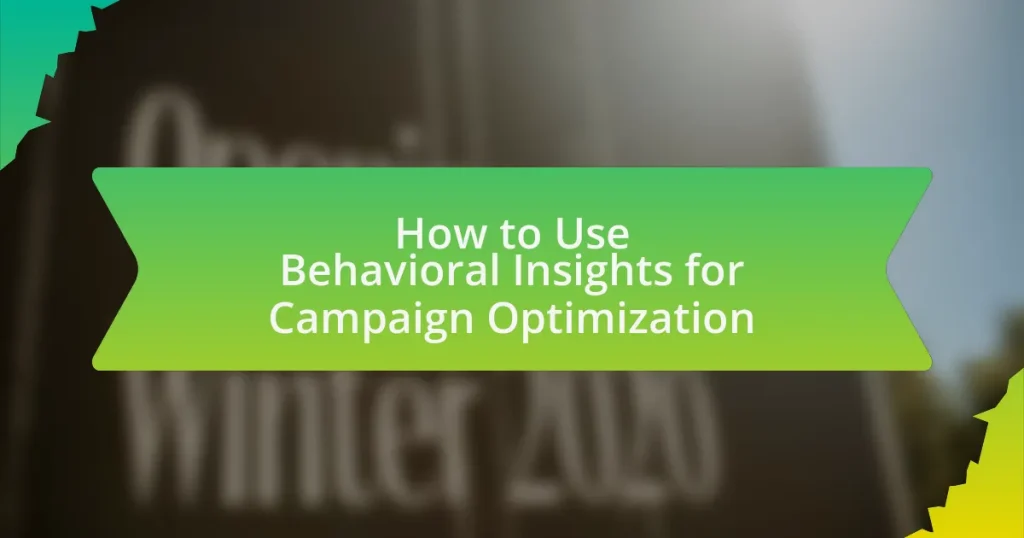Behavioral insights play a crucial role in campaign optimization by providing marketers with a deeper understanding of consumer behavior patterns and preferences. This article explores how these insights influence consumer decision-making through psychological factors such as perception, motivation, and emotions. It highlights the advantages of using behavioral insights over traditional marketing methods, including enhanced targeting and increased engagement rates. Additionally, the article outlines practical steps for integrating behavioral insights into marketing strategies, the importance of data analytics, and the challenges marketers may face, such as ethical considerations and data interpretation difficulties. Finally, it discusses future trends in leveraging technology, including AI and predictive analytics, to further optimize campaign effectiveness.
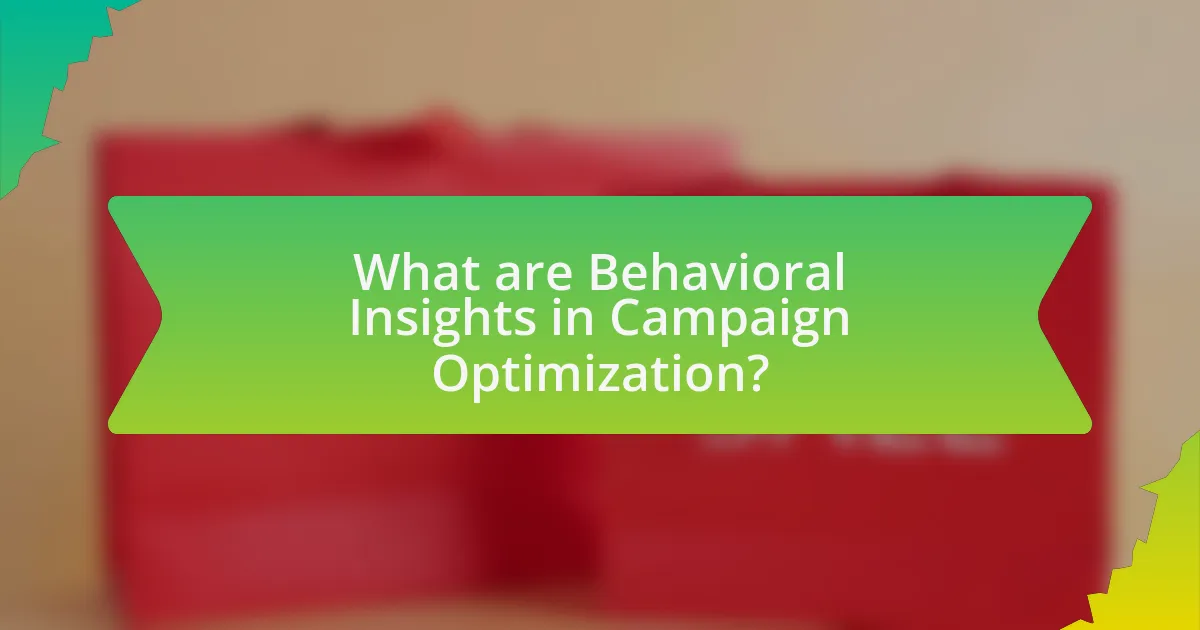
What are Behavioral Insights in Campaign Optimization?
Behavioral insights in campaign optimization refer to the understanding of consumer behavior patterns and preferences that inform marketing strategies. These insights are derived from data analysis, which reveals how individuals interact with campaigns, products, and brands. For example, studies show that personalized messaging can increase engagement rates by up to 50%, demonstrating the effectiveness of tailoring campaigns based on behavioral insights. By leveraging these insights, marketers can enhance targeting, improve customer experiences, and ultimately drive higher conversion rates.
How do Behavioral Insights influence consumer decision-making?
Behavioral insights significantly influence consumer decision-making by leveraging psychological principles to shape preferences and choices. These insights reveal that consumers often rely on heuristics, or mental shortcuts, which can lead to biases in their decision-making processes. For instance, the concept of loss aversion, established by Daniel Kahneman and Amos Tversky, indicates that consumers are more motivated to avoid losses than to acquire equivalent gains, impacting their purchasing behavior. Additionally, social proof, where individuals look to the behavior of others to inform their own choices, can drive consumer decisions, as evidenced by studies showing increased sales when products are endorsed by peers or celebrities. Thus, understanding these behavioral patterns allows marketers to design campaigns that align with consumer psychology, ultimately optimizing engagement and conversion rates.
What psychological factors are involved in consumer behavior?
Psychological factors involved in consumer behavior include perception, motivation, beliefs, attitudes, and emotions. Perception influences how consumers interpret marketing messages and product information, affecting their purchasing decisions. Motivation drives consumers to fulfill needs and desires, often categorized into intrinsic and extrinsic motivations. Beliefs and attitudes shape consumer preferences and can be influenced by personal experiences and social factors. Emotions play a critical role in decision-making, as positive or negative feelings towards a product can significantly impact consumer choices. Research indicates that these psychological factors collectively influence consumer behavior, as demonstrated in studies like “The Role of Emotions in Consumer Behavior” by Pham and Avnet, which highlights the importance of emotional responses in shaping purchasing decisions.
How can understanding these factors improve campaign strategies?
Understanding behavioral factors can significantly enhance campaign strategies by enabling marketers to tailor their messaging and targeting to align with consumer motivations and preferences. For instance, research indicates that campaigns utilizing behavioral insights can increase engagement rates by up to 30%, as they resonate more deeply with the audience’s needs and desires. By analyzing data on consumer behavior, such as purchasing patterns and emotional triggers, marketers can create more relevant content and optimize ad placements, leading to higher conversion rates and improved return on investment.
Why are Behavioral Insights important for marketers?
Behavioral insights are important for marketers because they provide a deeper understanding of consumer motivations and decision-making processes. By analyzing patterns in consumer behavior, marketers can tailor their strategies to align with the preferences and needs of their target audience. For instance, research from the Behavioral Insights Team shows that using behavioral nudges can increase engagement rates by up to 20%. This data demonstrates that leveraging behavioral insights not only enhances marketing effectiveness but also leads to improved customer satisfaction and loyalty.
What advantages do Behavioral Insights provide over traditional marketing methods?
Behavioral Insights offer significant advantages over traditional marketing methods by enabling marketers to understand consumer behavior more deeply and tailor their strategies accordingly. This approach leverages psychological principles and data analytics to predict how consumers will respond to various marketing stimuli, leading to more effective campaigns. For instance, a study by the Behavioral Insights Team found that using behavioral nudges increased response rates by up to 20% compared to conventional methods. Additionally, Behavioral Insights allow for real-time adjustments based on consumer interactions, enhancing engagement and conversion rates. This adaptability is often lacking in traditional marketing, which typically relies on static strategies and broad demographic targeting.
How can Behavioral Insights enhance customer engagement?
Behavioral insights can enhance customer engagement by tailoring marketing strategies to align with consumer behaviors and preferences. By analyzing data on customer interactions, businesses can identify patterns that reveal what motivates customers to engage, such as emotional triggers or social influences. For instance, research from the Behavioral Insights Team shows that personalized messaging can increase engagement rates by up to 50%, as it resonates more deeply with individual customers. This targeted approach not only improves the relevance of communications but also fosters a stronger emotional connection between the brand and the customer, ultimately leading to increased loyalty and higher conversion rates.
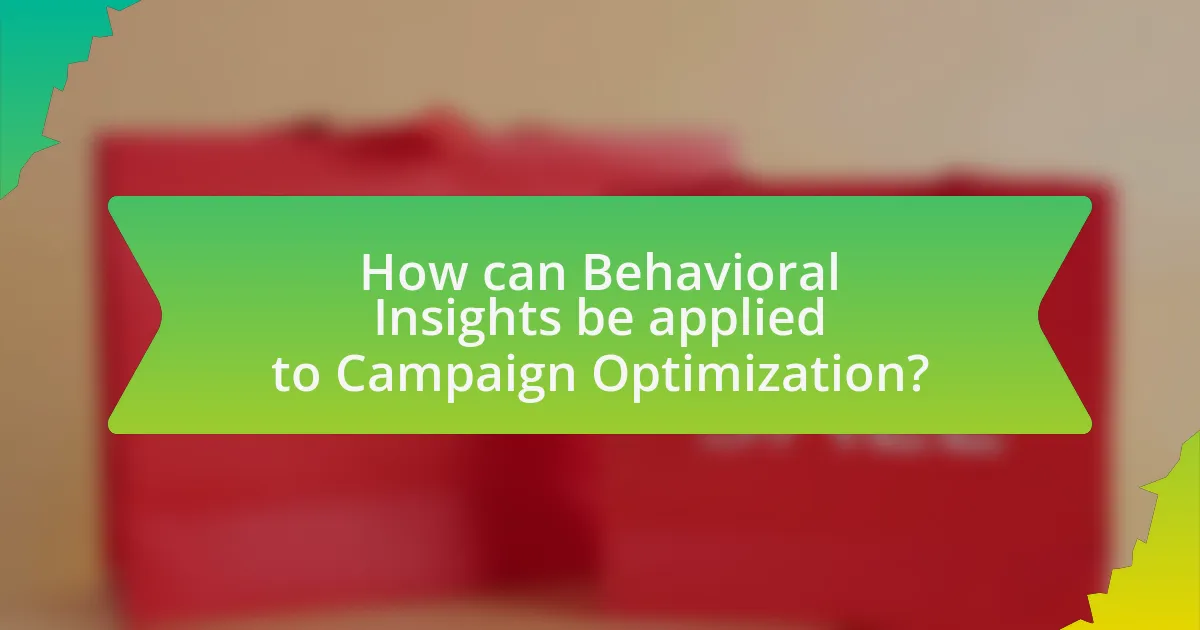
How can Behavioral Insights be applied to Campaign Optimization?
Behavioral insights can be applied to campaign optimization by analyzing consumer behavior patterns to tailor marketing strategies effectively. For instance, understanding the principles of nudging can help marketers design messages that resonate more with target audiences, leading to higher engagement rates. Research indicates that campaigns utilizing behavioral insights can improve conversion rates by up to 30%, as seen in studies conducted by the Behavioral Insights Team, which demonstrated that small changes in messaging significantly influenced consumer decisions. By leveraging these insights, marketers can create more personalized and effective campaigns that drive desired outcomes.
What steps should marketers take to integrate Behavioral Insights?
Marketers should take the following steps to integrate Behavioral Insights: first, they must collect and analyze data on consumer behavior through various channels such as surveys, website analytics, and social media interactions. This data helps identify patterns and preferences that inform marketing strategies. Next, marketers should segment their audience based on behavioral data to tailor messaging and offers that resonate with specific groups. Implementing A/B testing allows marketers to evaluate the effectiveness of different approaches and refine their strategies based on real-time feedback. Additionally, leveraging tools like customer journey mapping can help visualize the consumer experience and identify touchpoints for engagement. Finally, continuous monitoring and adjustment of campaigns based on behavioral insights ensure that marketing efforts remain relevant and effective. These steps are supported by research indicating that data-driven marketing strategies can lead to a 20% increase in sales effectiveness.
How can data analytics be utilized to gather Behavioral Insights?
Data analytics can be utilized to gather behavioral insights by analyzing large datasets to identify patterns and trends in consumer behavior. This process involves collecting data from various sources such as social media interactions, website analytics, and transaction histories, which can reveal how individuals engage with products or services. For instance, a study by McKinsey & Company found that companies leveraging data analytics for customer insights can improve their marketing effectiveness by up to 15-20%. By employing techniques such as clustering and predictive modeling, businesses can segment their audience based on behavior, enabling targeted marketing strategies that resonate with specific consumer needs and preferences.
What tools are available for analyzing consumer behavior?
Tools available for analyzing consumer behavior include Google Analytics, social media analytics platforms, survey tools like SurveyMonkey, and customer relationship management (CRM) systems such as Salesforce. Google Analytics provides insights into website traffic and user interactions, enabling businesses to understand consumer preferences and behaviors. Social media analytics platforms, like Hootsuite and Sprout Social, analyze engagement metrics to gauge consumer sentiment and trends. Survey tools, such as SurveyMonkey, allow businesses to gather direct feedback from consumers, providing qualitative insights into their motivations and preferences. CRM systems, like Salesforce, help track customer interactions and purchase history, offering a comprehensive view of consumer behavior over time. These tools collectively enable businesses to make data-driven decisions for optimizing marketing campaigns.
How can segmentation based on Behavioral Insights improve targeting?
Segmentation based on Behavioral Insights can significantly improve targeting by allowing marketers to tailor their messages and offers to specific consumer behaviors and preferences. This approach enables the identification of distinct groups within a larger audience based on their actions, such as purchasing habits, online interactions, and engagement levels. For instance, a study by the Harvard Business Review found that companies using behavioral segmentation saw a 20% increase in conversion rates compared to those using traditional demographic segmentation. By focusing on actual consumer behavior rather than assumptions, businesses can create more relevant and personalized marketing strategies, leading to higher engagement and improved customer satisfaction.
What are the different types of consumer segments based on behavior?
The different types of consumer segments based on behavior include loyal customers, switchers, price-sensitive consumers, and variety-seekers. Loyal customers consistently purchase a brand’s products and exhibit strong brand loyalty, often leading to repeat purchases. Switchers frequently change brands based on factors like promotions or availability, indicating a lack of commitment to any single brand. Price-sensitive consumers prioritize cost over brand loyalty, often seeking the best deals available. Variety-seekers enjoy trying new products and brands, driven by a desire for novelty rather than loyalty. These segments are essential for marketers to tailor their strategies effectively, as understanding consumer behavior can significantly enhance campaign optimization.
How can personalized messaging be developed using these segments?
Personalized messaging can be developed using segments by analyzing specific behavioral data to tailor content that resonates with each group. For instance, segmenting audiences based on their past interactions, preferences, and demographics allows marketers to create targeted messages that address the unique needs and interests of each segment. Research shows that personalized messages can increase engagement rates by up to 29%, as they are more relevant to the recipient. By leveraging insights from behavioral analytics, marketers can refine their messaging strategies, ensuring that each segment receives communications that are not only timely but also contextually appropriate, thereby enhancing overall campaign effectiveness.
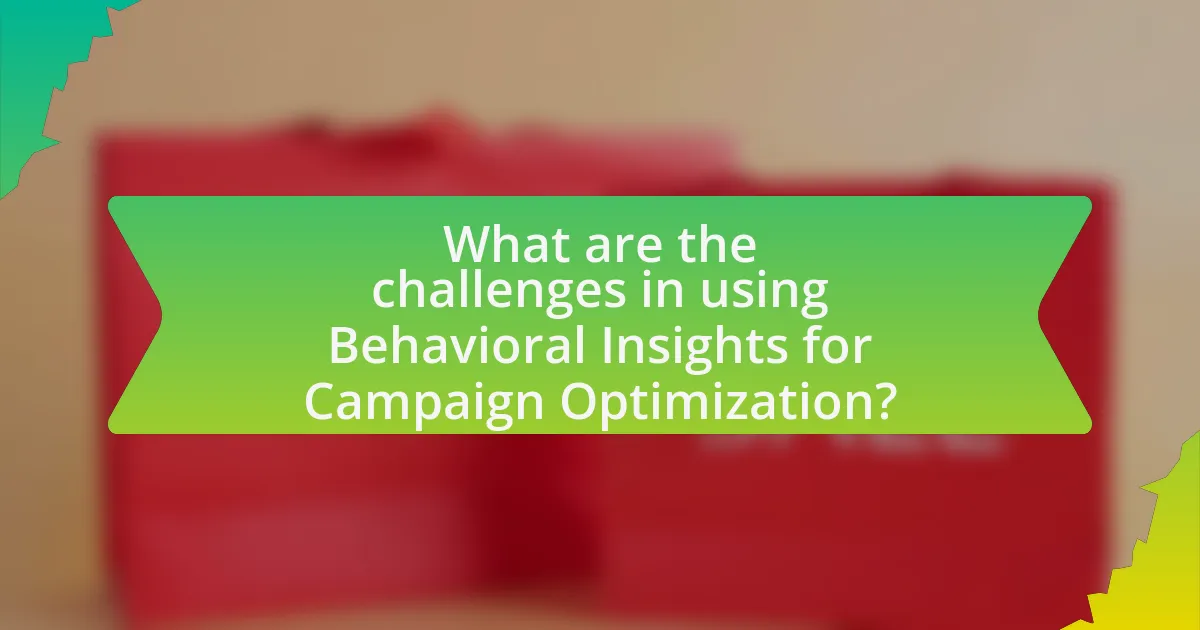
What are the challenges in using Behavioral Insights for Campaign Optimization?
The challenges in using Behavioral Insights for Campaign Optimization include data interpretation difficulties, the complexity of human behavior, and ethical considerations. Data interpretation difficulties arise because behavioral data can be noisy and context-dependent, making it hard to derive actionable insights. The complexity of human behavior presents a challenge as individuals often act irrationally or unpredictably, which can lead to ineffective campaign strategies. Ethical considerations are also significant, as leveraging behavioral insights may raise concerns about privacy and manipulation, potentially leading to backlash from consumers. These challenges necessitate careful analysis and ethical frameworks to ensure effective and responsible campaign optimization.
What common pitfalls should marketers avoid?
Marketers should avoid common pitfalls such as neglecting data analysis, failing to understand their target audience, and not testing their campaigns. Neglecting data analysis can lead to misguided strategies, as 70% of marketers report that data-driven decisions improve their marketing effectiveness. Failing to understand the target audience results in irrelevant messaging, which can decrease engagement rates significantly. Not testing campaigns before full implementation can waste resources; A/B testing has been shown to increase conversion rates by up to 300%.
How can misinterpretation of data lead to ineffective campaigns?
Misinterpretation of data can lead to ineffective campaigns by causing marketers to make decisions based on inaccurate insights. When data is incorrectly analyzed, it can result in targeting the wrong audience, misallocating resources, or implementing strategies that do not resonate with consumers. For instance, a study by the Nielsen Company found that 70% of marketing campaigns fail due to poor audience understanding, which often stems from misinterpreted data. This misalignment between campaign strategies and actual consumer behavior can significantly diminish engagement and conversion rates, ultimately undermining the campaign’s effectiveness.
What ethical considerations must be taken into account?
Ethical considerations in using behavioral insights for campaign optimization include informed consent, data privacy, and potential manipulation. Informed consent requires that individuals understand how their data will be used and the implications of their participation. Data privacy emphasizes the need to protect personal information and comply with regulations such as GDPR, which mandates transparency and user control over data. Potential manipulation refers to the ethical dilemma of influencing behavior in ways that may not align with the individual’s best interests, raising concerns about autonomy and fairness. These considerations are crucial to ensure responsible and ethical practices in campaign strategies.
How can marketers overcome these challenges?
Marketers can overcome challenges in using behavioral insights for campaign optimization by implementing data-driven strategies that leverage analytics and consumer behavior research. By utilizing advanced analytics tools, marketers can gain a deeper understanding of customer preferences and behaviors, allowing for more targeted and effective campaigns. For instance, a study by McKinsey & Company found that companies using data analytics to inform their marketing strategies can achieve a 15-20% increase in marketing effectiveness. Additionally, continuous testing and iteration of campaigns based on real-time feedback can help marketers adapt to changing consumer behaviors and preferences, ensuring that their strategies remain relevant and impactful.
What best practices should be followed for effective implementation?
Effective implementation of behavioral insights for campaign optimization requires a structured approach that includes clear goal setting, data-driven decision making, continuous testing, and stakeholder engagement. Clear goal setting ensures that the campaign objectives are well-defined and measurable, which aligns efforts and resources effectively. Data-driven decision making involves utilizing analytics to inform strategies, allowing for adjustments based on real-time feedback. Continuous testing, such as A/B testing, enables the identification of the most effective tactics, fostering an iterative improvement process. Stakeholder engagement is crucial for securing buy-in and collaboration, which enhances the campaign’s reach and impact. These practices are supported by research indicating that organizations employing structured methodologies achieve higher success rates in campaign outcomes.
How can continuous testing and iteration improve outcomes?
Continuous testing and iteration can significantly improve outcomes by enabling organizations to refine their strategies based on real-time feedback and data analysis. This approach allows teams to identify what works and what doesn’t, leading to more effective campaigns. For instance, a study by the Nielsen Norman Group found that iterative testing can increase user engagement by up to 50% when adjustments are made based on user behavior insights. By continuously testing different elements of a campaign, such as messaging or design, organizations can optimize their efforts, ultimately resulting in higher conversion rates and better overall performance.
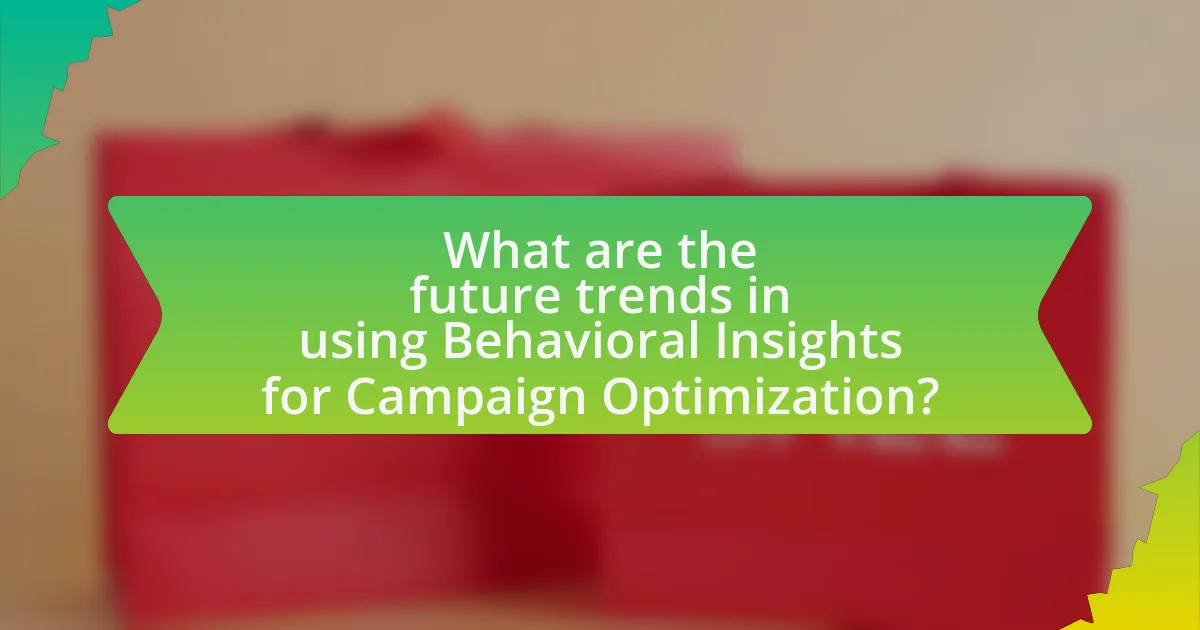
What are the future trends in using Behavioral Insights for Campaign Optimization?
Future trends in using Behavioral Insights for Campaign Optimization include increased personalization through data analytics, enhanced predictive modeling, and the integration of artificial intelligence. Personalization is driven by the ability to analyze consumer behavior patterns, allowing marketers to tailor messages and offers to individual preferences, which has been shown to increase engagement rates significantly. Enhanced predictive modeling utilizes behavioral data to forecast future consumer actions, enabling more effective targeting strategies. The integration of artificial intelligence facilitates real-time adjustments to campaigns based on behavioral feedback, optimizing performance dynamically. These trends are supported by research indicating that campaigns leveraging behavioral insights can achieve up to 30% higher conversion rates compared to traditional methods.
How is technology shaping the use of Behavioral Insights?
Technology is significantly shaping the use of Behavioral Insights by enabling the collection and analysis of vast amounts of data on consumer behavior. Advanced analytics tools and machine learning algorithms allow marketers to identify patterns and trends in real-time, facilitating more targeted and effective campaign strategies. For instance, platforms like Google Analytics and social media insights provide detailed metrics on user engagement, which can be leveraged to tailor messaging and optimize ad placements. This data-driven approach enhances the precision of behavioral insights, leading to improved campaign performance and higher conversion rates.
What role do AI and machine learning play in analyzing consumer behavior?
AI and machine learning play a crucial role in analyzing consumer behavior by enabling businesses to process vast amounts of data to identify patterns and trends. These technologies utilize algorithms to analyze consumer interactions, preferences, and purchasing habits, allowing for more accurate predictions of future behavior. For instance, a study by McKinsey & Company found that companies using AI for customer insights can increase their marketing ROI by 15-20%. This demonstrates that AI and machine learning not only enhance the understanding of consumer behavior but also significantly improve campaign effectiveness through data-driven decision-making.
How can predictive analytics enhance campaign strategies?
Predictive analytics enhances campaign strategies by enabling marketers to anticipate customer behavior and preferences, leading to more targeted and effective campaigns. By analyzing historical data and identifying patterns, predictive analytics allows for segmentation of audiences based on predicted responses, which can increase engagement rates. For instance, a study by McKinsey found that companies using predictive analytics in their marketing strategies can improve their campaign performance by up to 15-20%. This data-driven approach not only optimizes resource allocation but also enhances customer satisfaction by delivering personalized content that resonates with individual needs and interests.
What skills do marketers need to effectively leverage Behavioral Insights?
Marketers need analytical skills, understanding of consumer psychology, and data interpretation abilities to effectively leverage Behavioral Insights. Analytical skills enable marketers to assess data trends and consumer behaviors, while knowledge of consumer psychology helps them understand the motivations behind those behaviors. Data interpretation abilities allow marketers to translate complex data into actionable strategies. For instance, a study by the American Marketing Association highlights that marketers who utilize behavioral data can increase campaign effectiveness by up to 30%, demonstrating the importance of these skills in optimizing marketing efforts.
How can marketers develop a data-driven mindset?
Marketers can develop a data-driven mindset by prioritizing data analysis in their decision-making processes. This involves regularly collecting, analyzing, and interpreting data to inform marketing strategies and tactics. For instance, a study by McKinsey found that companies using data-driven marketing are six times more likely to be profitable year-over-year. By integrating analytics tools and fostering a culture of experimentation, marketers can enhance their understanding of consumer behavior and optimize campaigns effectively.
What training resources are available for marketers?
Training resources available for marketers include online courses, webinars, workshops, and certification programs focused on digital marketing and behavioral insights. Platforms such as Coursera, LinkedIn Learning, and HubSpot Academy offer structured courses that cover various aspects of marketing, including consumer behavior and campaign optimization strategies. Additionally, organizations like the American Marketing Association provide workshops and certifications that enhance marketers’ understanding of behavioral insights. These resources are validated by their widespread use in the industry, with many professionals citing them as essential for staying updated on marketing trends and techniques.
What are the best practices for implementing Behavioral Insights in campaigns?
The best practices for implementing Behavioral Insights in campaigns include understanding the target audience’s motivations, designing interventions based on behavioral theories, and testing and iterating on campaign strategies. Understanding the target audience involves conducting research to identify their preferences and pain points, which can inform tailored messaging. Designing interventions based on behavioral theories, such as nudging or social proof, can effectively influence decision-making. Testing and iterating on strategies through A/B testing allows for data-driven adjustments, enhancing campaign effectiveness. Research by the Behavioral Insights Team demonstrates that applying these practices can lead to significant improvements in engagement and conversion rates.
